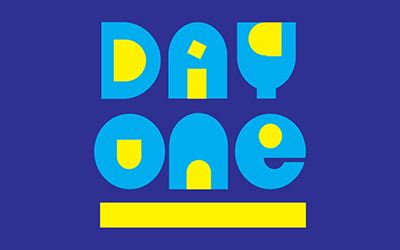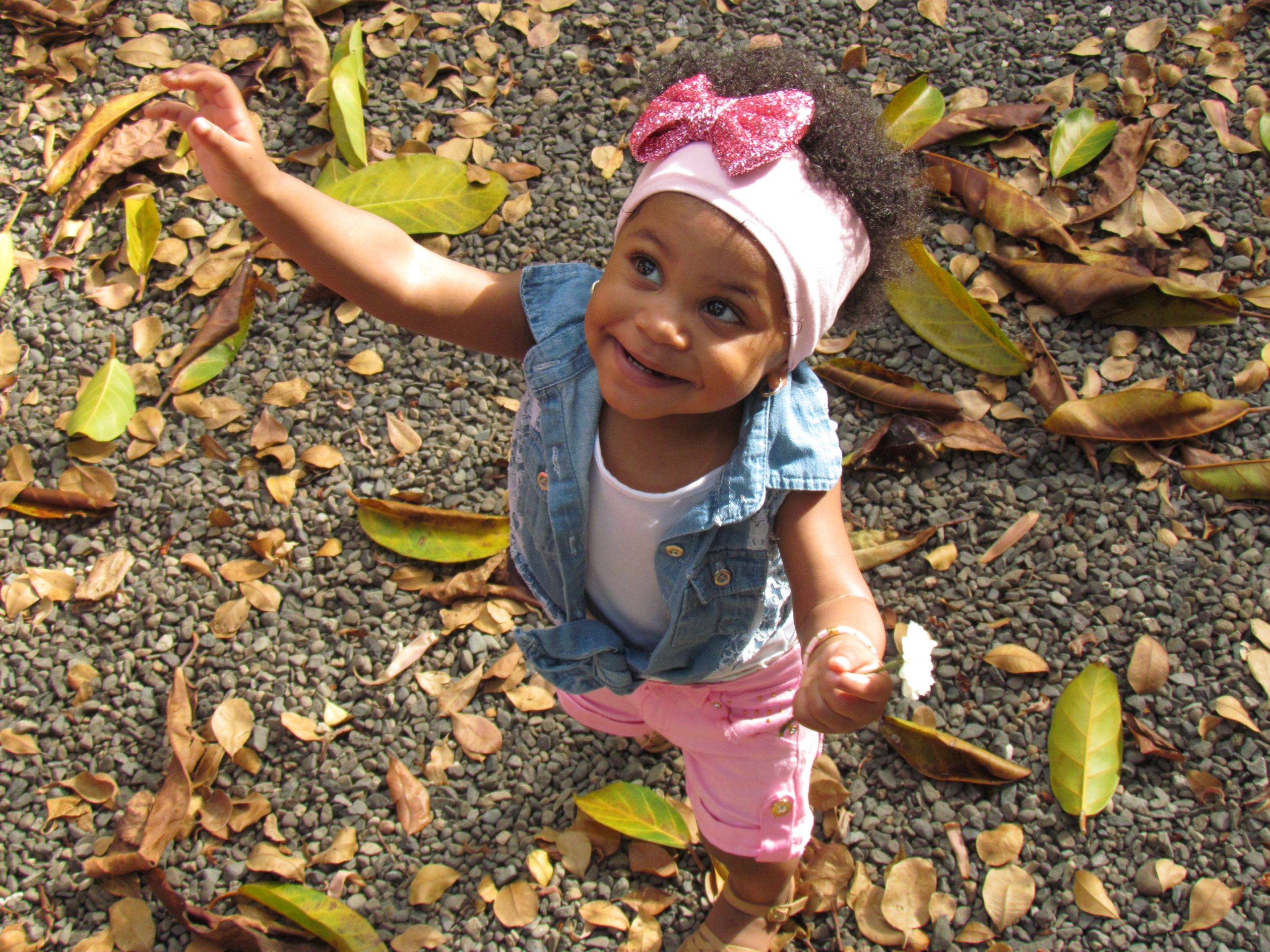Your Child’s Day
What might you see when you walk into an early childhood classroom at DAY ONE Teaching & Learning Center? Our classrooms are inviting and inspire a longing to stay and play. When you visit a DAY ONE TLC classroom, what you see reflects years of training, expertise and planning. Early childhood classroom environments and relationships are the core curriculum.
From the first hello to the last good-bye, children are learning through their daily schedule, play, and warm engagement with their teachers. Let’s take a tour through a child’s day at DAY ONE TLC!
Morning Arrival
Long before a child arrives at DAY ONE Teaching and Learning Center, the transition from home to school has been in motion. Your children may have been up for several hours before coming to school. They also may have just rolled out of bed. They may have had a good night’s sleep, or been awoken by a bad dream. They may have had a hearty breakfast or hardly had a bite to eat. These are examples of important information to share with a child’s teacher as they begin their day. They help the teacher to gauge how a child is doing and what kind of support to offer through the first few minutes of the day.
In our infant and toddler classrooms, teachers and parents establish relationships through dialogue in person, and via daily communication charts, by email or phone, and with an app that works on your cellphone. In our preschool classrooms, teachers use the app to share exciting adventures or special moments with a picture or endearing story. In all classrooms, teachers provide daily plans that articulate how they will address the developmental needs of each individual child. Parents are invited to speak with the teachers and/or the director about any concerns they might have about the program or their child’s development.
Morning arrival is also practice in routines and separation. Some children separate easily from a parent or caregiver from the first day of school. Other children keep working on separation for many weeks. Simple, consistent routines work best for most children and families. In an infant or waddler room, routines include helping a baby out of a carrier or stroller, washing hands together, sharing information about their night and morning, and giving extra snuggles before handing them to an infant room teacher. In an older toddler or preschool classroom, a child works toward independence through an arrival routine such as: go to your cubby, put away your coat and backpack, give three kisses to Mommy, and share a high five to have a great day! At any age, children often establish favorite “first things” to do after a parent leaves, like read a book with a teacher, wave goodbye from a window, or dive into a messy art project!
Meal Time
Mealtime at DAY ONE TLC includes breakfast, lunch and snack times. We offer children healthy meals, encouraging them to try something new by serving foods family style. In the infant and waddler rooms, sharing a meal is a time for social interaction, connecting with caregivers and peers. A baby being held in a teacher’s arms while drinking a bottle may share a gaze with each other. Older infants are ready to join peers and adults at a small table, learning to use spoons and discover new smells and textures. In the toddler and preschool rooms, mealtime is an opportunity to build on these skills. The children work toward independence (pouring one’s own juice, cleaning up one’s place) and simple table manners. Mealtimes also offer practice in sequencing and steps (e.g. wash hands, get cup and napkin, sit down, ask for items to be passed, eat, clean up). Conversations help children to get to know one another, discover similar interests, and rehearse memories of shared experiences (such as a field trip or morning adventure on the playground.)
At DAY ONE TLC, infant and waddler learning emerges within caring and responsive relationships. Infants and waddlers are integrating their sense of body and mind, revealing their personalities in body language, sounds and words. We build relationships with the children by the way we respectfully handle their bodies, and affirm their emotions. Infants and waddlers build relationships with us by accepting our care and by caring for each other. Children are given the opportunity to spend each day developing their bodies and minds with as few impingements as reasonable. Opportunities to explore, manipulate, and make meaning of the world around them forms the basis of our curriculum.
Circle Time
Once or twice a day, toddlers and preschoolers gather for circle. This is an opportunity to learn turn-taking skills, practice self-regulation, and share exciting information. Circle time often provides a plan for the day, such as what activities will be offered.
Open Choice Activities
Open choice activities are the heart of planning a curriculum for older toddlers and preschoolers. Each activity provides a variety of learning opportunities. Learning to make choices and become independent are important skills. This is why the furniture is child-sized, with space for their belongings, and the children can reach items themselves. The room is organized with several areas for play and exploration, including an area for art, blocks, books, gathering, pretend play, manipulatives and sensory activities, and writing. Here is a quick peek at each classroom area.
Art Area
Each classroom will have its own art area, including an easel or a table with art supplies. On any given day, art may also occur on the floor, wall or hallway with larger mural paper, cardboard, etc. Art activities are open-ended, offering opportunities for creative expression. Art is also an early literacy and science activity. Creating meaning on paper is a form of literacy and communication. Colors, light and textures contribute to observation and experimentation, key to science learning. Children will also have regular time to create in the art studio, located on the ground floor.
Block Area
In this area, blocks are arranged by shape and size and stored with the surface of their main shape facing out. This helps children to visually see geometric proportions and ratios. For example, how many square blocks does it take to cover one rectangle block? Cut out shapes of the blocks are taped to the shelves to help children learn to sort them at clean up time.
Block building encourages many developmental skills. Math skills include geometry and fractions. Science skills include experimentation, trial and error, balance and simple physics. Communication and literacy skills come through story telling or fantasy play built around the blocks. Signs may be added to the block area (names of buildings, messages to others to be careful not to knock it over). Active block construction often includes several children, who need to consider each other’s ideas and perspectives – an important life skill.
Books and Cozy Area
Books are essential in our DAY ONE TLC classrooms! They are displayed so their covers are visible at eye-level to the child, or in small baskets in a cozy nook. Books are key for developing early literacy skills and promoting language development. In addition, children need quiet spaces where they can go when they need some time to learn how to calm down or relax when they are overwhelmed. This is an important way to help encourage self-regulation skills.
Manipulatives and Puzzles
Manipulatives are toys or objects that children can manipulate. Common examples are Legos, bristle blocks, and puzzles. Manipulatives for preschoolers are typically objects that fit together in interesting or unique ways. This encourages children to think “outside of the box.” Puzzles are excellent for learning about spatial and part-whole relationships. Manipulatives and puzzles strengthen fine motor skills, hand-eye coordination, and problem-solving.
Pretend Play
Pretend or fantasy play includes a variety of props around a specific theme. Each week, pretend play areas may change, perhaps from a space ship one week to a bakery shop the next. Creativity abounds and children learn ideas from one another as they create their play together. Cooperation, communication, perspective-taking and problem-solving are at the heart of pretend play.
Sensory and Texture Table
These may be located in separate areas in a classroom or a single space, depending on available space. Sensory tables have items such as play-dough, oobleck and gak. Texture tables have the advantage of holding water, sand or snow. Sensory experiences are important for young children’s rapidly developing sensory systems. Texture, smell, and color are common sensory experiences that can come from playing with a single material, such as play dough. Learning about science includes observation, trying something, and seeing what happens. As children pour, dump, and squeeze materials, they observe the resulting change. Exploring different sensory materials also provides experiences in learning about weight and volume (math concepts). Sensory tables provide for creativity and relaxation or self-calming – important steps in learning how to self-regulate.
Writing Table
The writing table is an area where children experiment with different types of writing tools. These are typically crayons and markers for younger preschoolers, and expand to colored pencils and beginner writing pencils as children approach age five. The writing table is designed to help children practice fine motor skills and learn that print (including simple marks on paper) have meaning.
Making valentines is a good example of a writing activity that is a way to communicate feelings with one another.
Outdoor Play
DAY ONE Teaching & Learning Center will have beautiful outdoor areas for play, exploration and gardening. Outdoor play is essential for healthy growth and development. Fresh air and exploration of the natural world helps to develop a sense of curiosity and wonder. Active play outside develops a child’s strength, coordination and ease of movement in different types of spaces. For example, how we move indoors in a classroom with furniture and less space is different than moving outdoors on grass or climbing structures. Active movement each day creates healthy habits and healthy bodies.
Rest Time
If your child is attending DAY ONE TLC for a full day, rest time will be part of their day. Many children complain about or resist rest time. Yet most young children need some downtime in the midst of an active day. Resting our bodies quietly is another way children learn self-regulation skills. Familiar comfort items are important for many children; these may include a favorite blanket, pillow or stuffed animal.
Heading Home
The transition from school to home is perhaps the most important one of the day. It completes the circle of trust among parent, child and teacher. A warm good-bye makes for an easier hello and start of the next school day.


